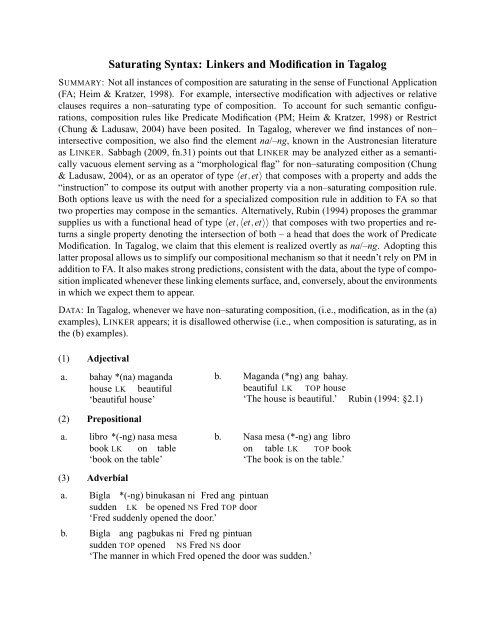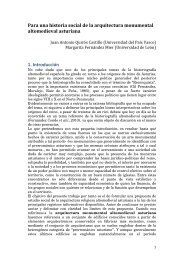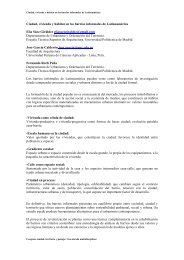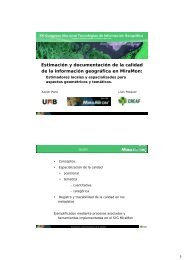Saturating Syntax: Linkers and Modification in Tagalog
Saturating Syntax: Linkers and Modification in Tagalog
Saturating Syntax: Linkers and Modification in Tagalog
Create successful ePaper yourself
Turn your PDF publications into a flip-book with our unique Google optimized e-Paper software.
<strong>Saturat<strong>in</strong>g</strong> <strong>Syntax</strong>: <strong>L<strong>in</strong>kers</strong> <strong>and</strong> <strong>Modification</strong> <strong>in</strong> <strong>Tagalog</strong><br />
SUMMARY: Not all <strong>in</strong>stances of composition are saturat<strong>in</strong>g <strong>in</strong> the sense of Functional Application<br />
(FA; Heim & Kratzer, 1998). For example, <strong>in</strong>tersective modification with adjectives or relative<br />
clauses requires a non–saturat<strong>in</strong>g type of composition. To account for such semantic configurations,<br />
composition rules like Predicate <strong>Modification</strong> (PM; Heim & Kratzer, 1998) or Restrict<br />
(Chung & Ladusaw, 2004) have been posited. In <strong>Tagalog</strong>, wherever we f<strong>in</strong>d <strong>in</strong>stances of non–<br />
<strong>in</strong>tersective composition, we also f<strong>in</strong>d the element na/–ng, known <strong>in</strong> the Austronesian literature<br />
as LINKER. Sabbagh (2009, fn.31) po<strong>in</strong>ts out that LINKER may be analyzed either as a semantically<br />
vacuous element serv<strong>in</strong>g as a “morphological flag” for non–saturat<strong>in</strong>g composition (Chung<br />
& Ladusaw, 2004), or as an operator of type 〈et,et〉 that composes with a property <strong>and</strong> adds the<br />
“<strong>in</strong>struction” to compose its output with another property via a non–saturat<strong>in</strong>g composition rule.<br />
Both options leave us with the need for a specialized composition rule <strong>in</strong> addition to FA so that<br />
two properties may compose <strong>in</strong> the semantics. Alternatively, Rub<strong>in</strong> (1994) proposes the grammar<br />
supplies us with a functional head of type 〈et,〈et,et〉〉 that composes with two properties <strong>and</strong> returns<br />
a s<strong>in</strong>gle property denot<strong>in</strong>g the <strong>in</strong>tersection of both – a head that does the work of Predicate<br />
<strong>Modification</strong>. In <strong>Tagalog</strong>, we claim that this element is realized overtly as na/–ng. Adopt<strong>in</strong>g this<br />
latter proposal allows us to simplify our compositional mechanism so that it needn’t rely on PM <strong>in</strong><br />
addition to FA. It also makes strong predictions, consistent with the data, about the type of composition<br />
implicated whenever these l<strong>in</strong>k<strong>in</strong>g elements surface, <strong>and</strong>, conversely, about the environments<br />
<strong>in</strong> which we expect them to appear.<br />
DATA: In <strong>Tagalog</strong>, whenever we have non–saturat<strong>in</strong>g composition, (i.e., modification, as <strong>in</strong> the (a)<br />
examples), LINKER appears; it is disallowed otherwise (i.e., when composition is saturat<strong>in</strong>g, as <strong>in</strong><br />
the (b) examples).<br />
(1) Adjectival<br />
a. bahay *(na) mag<strong>and</strong>a<br />
house LK beautiful<br />
‘beautiful house’<br />
b. Mag<strong>and</strong>a (*ng) ang bahay.<br />
beautiful LK TOP house<br />
‘The house is beautiful.’ Rub<strong>in</strong> (1994: §2.1)<br />
(2) Prepositional<br />
a. libro *(-ng) nasa mesa<br />
book LK on table<br />
‘book on the table’<br />
b. Nasa mesa (*-ng) ang libro<br />
on table LK TOP book<br />
‘The book is on the table.’<br />
(3) Adverbial<br />
a. Bigla *(-ng) b<strong>in</strong>ukasan ni Fred ang p<strong>in</strong>tuan<br />
sudden LK be opened NS Fred TOP door<br />
‘Fred suddenly opened the door.’<br />
b. Bigla ang pagbukas ni Fred ng p<strong>in</strong>tuan<br />
sudden TOP opened NS Fred NS door<br />
‘The manner <strong>in</strong> which Fred opened the door was sudden.’
(4) Relative clause<br />
a. bahay *(na) nakita ko<br />
house LK saw I<br />
‘house that I saw’<br />
b. Nakita ko (*ng) ang bahay<br />
saw I LK TOP house<br />
‘I saw the house.’<br />
(5) Weak vs. strong quantification<br />
a. marami *(-ng) bata<br />
b. bawa’t (*na) bata<br />
many LK child<br />
each/every LK child<br />
‘many children’<br />
‘each/every child’<br />
PROPOSAL: Given the distribution of LINKER, we follow Rub<strong>in</strong> (1994) <strong>in</strong> propos<strong>in</strong>g that the<br />
semantics of this morpheme be that of a functional element perform<strong>in</strong>g modification, rather than<br />
simply “flagg<strong>in</strong>g” it:<br />
(6) [[LINKER]]=λP. λQ. λx. P(x) = Q(x) = 1<br />
At this po<strong>in</strong>t we would like to take the evidence from <strong>Tagalog</strong> to suggest that PM is not a necessary<br />
composition rule, <strong>and</strong> that where it has previously been posited, we <strong>in</strong> fact have functional heads<br />
responsible for non–<strong>in</strong>tersective modification. Thus, we do away with the need for non–saturat<strong>in</strong>g<br />
semantic composition, <strong>and</strong> the flagg<strong>in</strong>g thereof, <strong>and</strong> simplify our compositional <strong>in</strong>ventory by remov<strong>in</strong>g<br />
unnecessary rules; FA is sufficient. It should be noted that the burden has now been shifted<br />
to the syntax, which we claim is responsible for the composition of complex properties.<br />
IMPLICATIONS: Assum<strong>in</strong>g that LINKER signals non–saturat<strong>in</strong>g composition, its co-occurance<br />
with complement clauses suggests that these too are modificational, <strong>and</strong> not complements per se.<br />
(7) a. Kailangan *(-ng) magbasa ng libro si Pedro<br />
need LK read NS book TOP Pedro<br />
‘It needs to be the case that Pedro reads a book.’<br />
b. Kailangan ni Pedro *(-ng) magbasa ng libro<br />
need NS Pedro LK read NS book<br />
‘Pedro needs to read a book.’<br />
Such reason<strong>in</strong>g is <strong>in</strong> l<strong>in</strong>e with recent theoriz<strong>in</strong>g on the syntax of clausal complements, where<strong>in</strong><br />
CPs do not saturate argument positions (cf. Moulton, 2011).<br />
REFERENCES:<br />
Chung, S<strong>and</strong>ra & William Ladusaw. 2004. Restriction <strong>and</strong> Saturation. Cambridge. MIT Press.<br />
Heim, Irene & Angelika Kratzer. 1998. Semantics <strong>in</strong> Generative Grammar. Oxford: Blackwell.<br />
Moulton, Keir. 2011. CPs don’t saturate: the distribution of clausal complements. Talk presented<br />
at University of Gött<strong>in</strong>gen.<br />
Rub<strong>in</strong>, Edward. 1994. <strong>Modification</strong>: A Syntactic Analysis <strong>and</strong> its Consequences. Ph.D. Dissertation,<br />
Cornell University.<br />
Sabbagh, Joseph. 2009. Existential Sentences <strong>in</strong> <strong>Tagalog</strong>. Natural Language <strong>and</strong> L<strong>in</strong>guistic Theory<br />
27:675-719.











